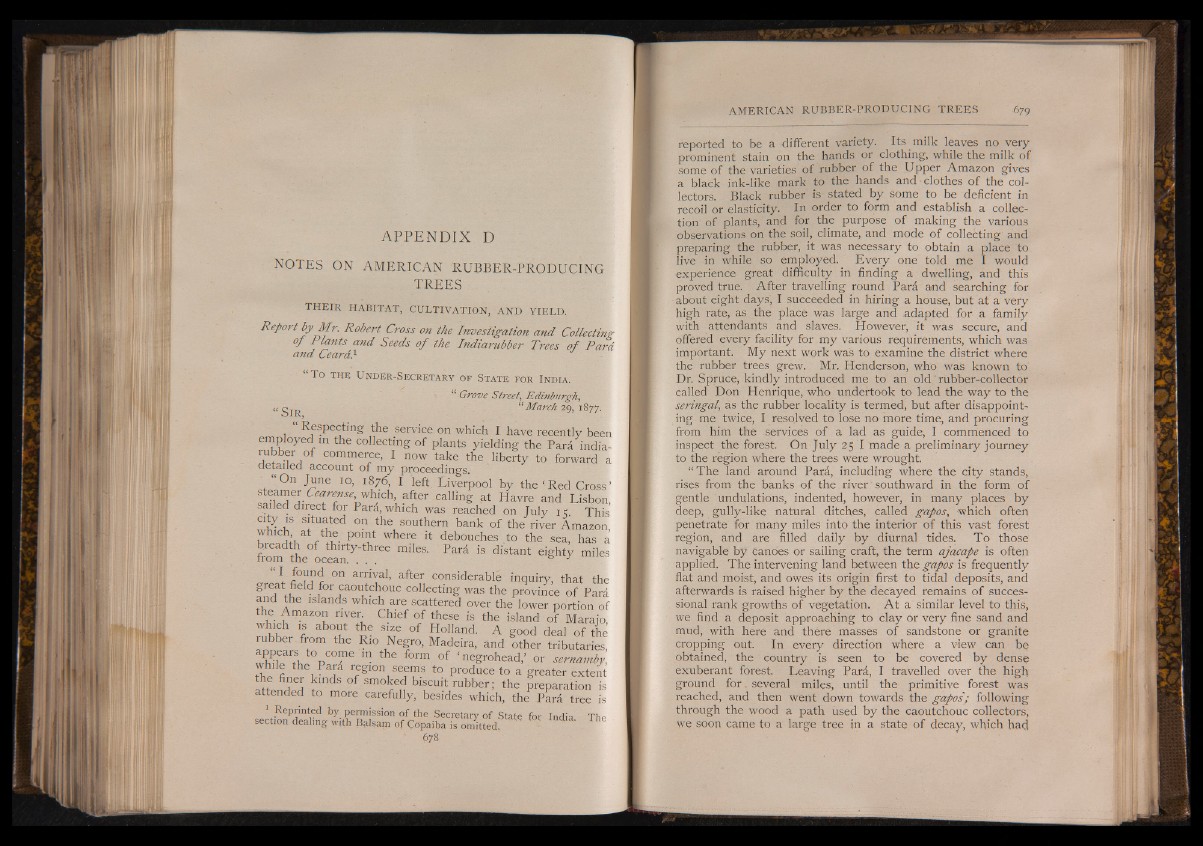
A P P E N D I X D
NOTES ON AMERICAN RUBBER-PRODUCING
TREES
THEIR HABITAT, CULTIVATION, AND YIELD.
Report by Mr. Robert Cross on the Investigation and Collecting
° j Plants and Seeds o f the Indiarubber Trees o f Para
and Ceard} -
“ To t h e U n d e r - S e c r e t a r y o f S t a t e f o r I n d i a .
“ Grove Street, Edinburgh,
« g IR ' “ March 29, 1877.
“ Respecting the service on which I have recently been
employed m the collecting of plants yielding the Pard india-
rubber of commerce, I now take the liberty to forward a
detailed account of my proceedings.
On June 10, 1876, I left Liverpool by the ‘ Red Cross ’
steamer Cearense.which, after calling at Havre and Lisbon,
sailed direct for Para, which was reached on July 1 e. This
city is situated on the southern bank of the river Amazon
v j R atr i e P01’lt: where it debouches to the sea, has a
breadth of thirty-three miles. Para is distant eighty miles
from the ocean. . . . & * %
1 1 ° n arnval> after considerable inquiry, that the
for caoutchouc collecting was the province of Para
and the islands which are scattered over the lower portion of
the Amazon river Chief of these is the island of Maraio
which is about the size of Holland. A good deal of the
rubber from the Rio Negro, Madeira, and other tributaries
i r i pC° f e “ thC f°rm ° f I negrohead,’ or sernamby,
r i l l , ] region seems to produce-to a greater extent
r 1 (Ml blf uit ™bber; the preparation is
attended to more carefully, besides which, the Par A tree is
Reprinted by permission of the Secretary of State for India The
section dealing with Balsam of Copaiba is omitted. .
' -678
reported to be a different variety. Its milk leaves no very
prominent stain on the hands or clothing, while the milk of
some of the varieties of rubber of the Upper Amazon gives
a black ink-like mark to the hands and - clothes of the collectors.
Black rubber is stated by some to be deficient in
recoil or elasticity. In order to form and establish a collection
of plants, and for the purpose of making the various
observations on the soil, climate, and mode of collecting and
preparing the rubber, it was necessary to obtain a place to
live in while so employed. Every one told me I would
experience great difficulty in finding a dwelling, and this
proved true. After travelling round Pard and searching for
about eight days, I succeeded in hiring a house, but at a very
high rate, as the place was large and adapted for a family
with attendants and slaves. However, it was secure, and
offered every facility for my various requirements, which was
important. My next work was to examine the district where
the rubber trees grew. Mr. Henderson, who was known to
Dr. Spruce, kindly introduced me to an old' rubber-collector
called Don Henrique, who undertook to lead the way to the
seringal, as the rubber locality is termed, but after disappointing
me twice, I resolved to lose no more time, and procuring
from him the services of a lad as guide, I commenced to
inspect the forest. On July 25 I made a preliminary journey
to the region where the trees were wrought.
“ The land around Para, including where the city stands,
rises from the banks of the river southward in the form of
gentle undulations, indented, however, in many places by
deep, gully-like natural ditches, called gapos, which often
penetrate for many miles into the interior of this vast forest
region, and are filled daily by diurnal tides. To those
navigable by Canoes or sailing craft, the term ajacape is often
applied. The intervening land between the gapos is frequently
flat and moist, and owes its origin first to tidal deposits, and
afterwards is raised higher by the decayed remains of succes-
sional rank growths of vegetation. A t a similar level to this,
we find a deposit approaching to clay or very fine sand and
mud, with here and there masses of sandstone or granite
cropping out. In every direction where a view can be
obtained, the country is seen to be covered by dense
exuberant forest. Leaving Pard, I travelled over the high
ground for. several miles, until the primitive forest was
reached, and then went down towards the gapos; following
through the wood a path used by the caoutchouc collectors,
we soon came to a large tree in a state of decay, which had